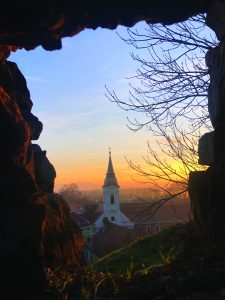50 Europe: Cultural Geography I – Religion in Europe
Christianity
 Armenia is the world’s oldest Christian nation, but it was the Christianization of the Roman Empire that would be the decisive moment for the religion. In the 4th century, the Roman Emperor Constantine legalized Christianity, and later converted to it.
Armenia is the world’s oldest Christian nation, but it was the Christianization of the Roman Empire that would be the decisive moment for the religion. In the 4th century, the Roman Emperor Constantine legalized Christianity, and later converted to it.
In Europe outside the Roman Empire, Christianity diffused down the socio-political hierarchy. Even after the fall of Rome, emperors, kings, and tsars recognized the political advantages of embracing what had become the region’s largest faith. So, the monarch would convert to Christianity. After that, all of his subjects were expected to do the same.

For several centuries, Rome remained the center of European Christianity, and most of the region’s Christians were followers of the Roman Catholic Church. Today, the Roman Church is still the largest Christian group in Europe, and the largest in the world. Countries where Catholics have traditionally formed the majority include Poland, the Czech Republic, Slovakia, Croatia, Slovenia, Germany, the Netherlands, Belgium, Austria, Switzerland, Ireland, Luxembourg, France, Italy, Spain, Portugal, Hungary, Lithuania, and Malta.
A second major branch of Christianity emerged in the 11th century. Although Eastern Orthodox Christianity traces its theological roots to early Catholicism, it emerged as a separate denomination in 1054 CE when a number of Christian nations in Eastern Europe broke from Roman authority. Its structure is somewhat different from the Roman Catholic Church. The Catholic Church throughout the world is still governed from Rome, and headed by the pope. While Eastern Orthodox Christians recognize the Archbishop of Constantinople (Istanbul) as the symbolic head of their Church, the various national Eastern Orthodox Churches are largely governed separately. Most Eastern Orthodox nations possess their own branch of the Orthodox Church, including the Greek, Bulgarian, Romanian, Serbian, and Russian Orthodox Churches.
The third major branch of Christianity in Europe is Protestantism. The Protestant Reformation began in 1521 CE, when a German theologian named Martin Luther leveled numerous criticisms at the Roman Catholic Church. Luther himself was a devout Catholic, but he believed that the Roman Church had corrupted the true nature of Christianity, having strayed too far from scripture. His protests (hence the term “Protestant”) led to his excommunication, and he and his followers founded a new movement that came to be known as Lutheranism. Lutherans are now the largest religious group in northern Germany and Scandinavia (Norway, Sweden, Iceland, and Denmark). Another major Protestant reformer was John Calvin, and Calvinist churches (such as the Dutch Reformed Church and Presbyterian Church) found significant numbers of followers in the Netherlands and Scotland.
An unusual hybrid between Catholicism and Protestantism can be found in England. The Church of England (also called the Anglican, or Anglo-Catholic Church) had a rather unusual beginning. England had been a predominantly Roman Catholic country until 1534, when King Henry VIII rejected Roman papal authority, largely because the pope refused to annul his marriage. Henry still considered himself Catholic, just not a Roman Catholic, and initially there was little change in English Christianity (to this day, an Anglican mass would look very familiar to Roman Catholics). Still, Anglicans are generally regarded as Protestants, particular after Henry’s son, Edward VI, began to embrace numerous theological elements of the Protestant Reformation. That is why the Church of England officially regards itself as both Catholic and Reformed.
For an excellent map of religious patterns in Europe, go to: https://www.churchpop.com/wp-content/uploads/2014/10/traditional-religions.png
Non-Religious Populations
Organized religion has been declining in Europe in recent decades. In most countries, the majority of the population still have at least a nominal association with one religious denomination or another, although rates of regular participation in religious services are relatively low in Europe when compared to much of the rest of the world. Still, non-religious populations are the majority in just three European countries: The Netherlands, Estonia, and the Czech Republic. In Europe as a whole, about one in four people identify as non-religious, although that varies widely from country to country. For example, the Czech Republic and Poland are two traditionally Catholic countries that neighbor one another. Today, 89% of Czechs are non-religious, while 86% of Poles remain Catholic.
Islam
 Islam arrived in Europe via Ottoman rule in the 1400s. At its height, the Ottoman Empire (based in modern-day Turkey) controlled much of the Balkan and Greek peninsulas. While under Ottoman rule, many Europeans converted to Islam. As a result, Muslims are today the largest religious group in Bosnia (50% Muslim), Albania (59%), and Kosovo (90%). Islam is also the fastest growing religion in Europe, largely as a result of immigration from Muslim countries in Africa and Asia. Today, there are sizable Muslim populations in Germany (5 million Muslims), France (5 million), Britain (3 million), and Italy (2 million).
Islam arrived in Europe via Ottoman rule in the 1400s. At its height, the Ottoman Empire (based in modern-day Turkey) controlled much of the Balkan and Greek peninsulas. While under Ottoman rule, many Europeans converted to Islam. As a result, Muslims are today the largest religious group in Bosnia (50% Muslim), Albania (59%), and Kosovo (90%). Islam is also the fastest growing religion in Europe, largely as a result of immigration from Muslim countries in Africa and Asia. Today, there are sizable Muslim populations in Germany (5 million Muslims), France (5 million), Britain (3 million), and Italy (2 million).
Judaism
In the first century CE, the Jewish homeland in Southwest Asia was under Roman rule. When the Jews unsuccessfully rebelled against them, the Romans exiled the Jews from their homeland – an event known as the Diaspora. The Jews were scattered to all parts of the Roman Empire, but the densest concentration would eventually be in Europe. In 1880, about 90% of the world’s Jewish population was in Europe, with particularly dense concentrations in countries like Poland and Russia. Around this time, Jewish migration to the Americas began to accelerate, primarily to large American cities like New York and Chicago.
Even with significant emigration, about 60% of the world’s Jewish population remained in Europe at the dawn of World War II in 1939. During the war, Jews who fell under the occupation of fascist governments, such as that of Nazi Germany, suffered horrific consequences. More than six million Jews died during the ensuing Holocaust as a result of starvation, deprivation, slavery, or systematic murder in fascist concentration camps. By the end of the war in 1945, 36% of the world’s Jewish population had been killed, including nearly two-thirds of European Jews. After the war, most of Europe’s remaining Jews migrated elsewhere, primarily to the United States or Israel. Today, only about 7% of the world’s Jewish population lives in Europe.
Did You Know?
Cited and additional bibliography:
ChurchPOP. 2014. 10 Revealing Maps of Religion in Europe. https://www.churchpop.com/2014/10/09/10-maps-religion-europe/.
Kugel, Josh. 2020. Basilica of Esztergom, Esztergom, Hungary. St. Olaf College, Class of 2022.


